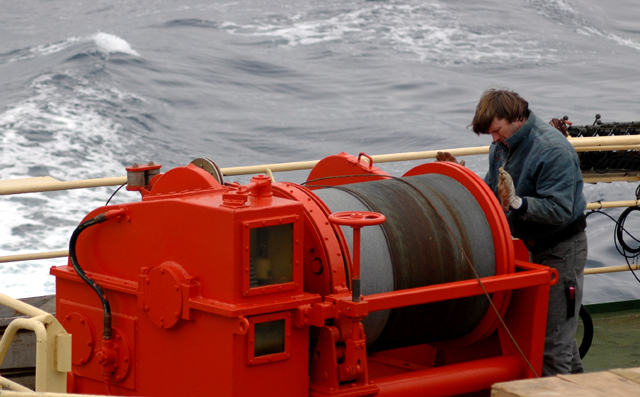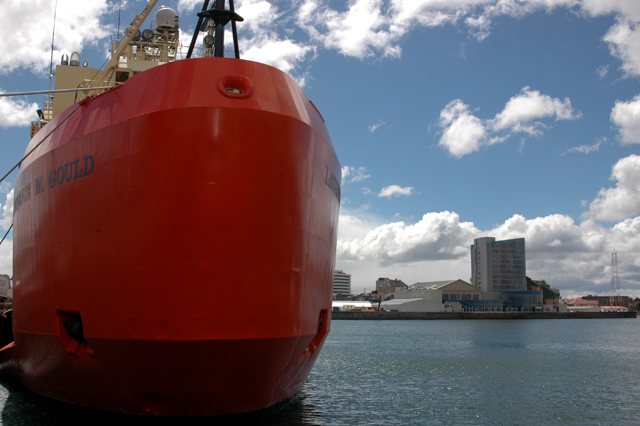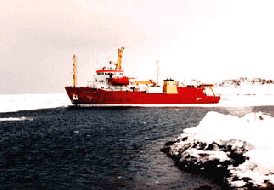Rekindled passionD'Aoust returns to USAP support role after long absencePosted February 5, 2010
Tony D’Aoust likes to say he found enlightenment while living in a converted city bus, but he seems to have found his purpose in life while working for the U.S. Antarctic Program “I feel like I have the best gig going,” says D’Aoust, sitting in the lounge of the ARSV Laurence M. Gould As one of the electronics technicians (ETs) aboard the ship working for Raytheon Polar Services Co. The rosette is a nearly car-sized, rounded cage that carries 24 plastic tubes that collect water samples at varying depths, along with an instrument package that measures ocean properties like salinity and temperature. It’s one of the key instruments for the PAL LTER scientists, who deploy it at every stop along their sampling grid, the centerpiece of a nearly 20-year study of the marine ecosystem. Loss of communication from the instrument was a showstopper. D’Aoust and IT technician Mike Coons had the CTD fixed and back in the water in a couple of hours. “I really just like making things work,” says the 44-year-old who looks about half his real age. Tall and trim, with shaggy brown hair and hawkish nose, D’Aoust seems indefatigable and impish. Only the fine creases along his eyes hint at a deeper maturity and wisdom. Born in San Diego, where his father was a graduate student at Scripps Institution of Oceanography Instead, he dropped out of high school while living on Bainbridge Island, Wash., one credit shy of graduating. As early as age 13 he had already developed an independent streak, moving out of the house each year to live in increasingly bigger tents on his folks’ property. After quitting school, he bought a big city transit bus for $400 and a pair of huge eight-volt tugboat batteries for $5 that he was able to salvage to help power his new home. So began a life of autodidacticism.
D’Aoust eventually headed north to Port Townsend, about 40 miles away, and took up commercial fishing. It’s the sort of job, he explains, where you get an opportunity to learn a variety of skills. “If it’s important, you have to try and fix it,” he says.
He eventually ended up in Kodiak, Alaska, fishing for salmon and halibut. It was during this time that he met someone who had worked in Antarctica. He immediately found the idea intriguing, and applied for half-a-dozen jobs.
Worried that he might miss the phone call that would send him to Antarctica, D’Aoust declined a lucrative share in a halibut-fishing trip and moved back to Port Townsend. He lived out of his car and a cardboard box on the beach, using a friend’s phone to stay in touch. “I eventually did get hired, and so the gamble paid off,” D’Aoust says, though admits the salary for a McMurdo Station But he was after adventure, not money, and quickly fell in love with the place. Soon after arriving on the Ice in 1988, D’Aoust began looking for a way to extend his stay into the winter. He eventually scored the only winter-over position at the Berg Field Center, which supports the science field camps with outdoor gear. “When you’re a GFA you’re like a pawn in chess – you can become anything,” D’Aoust muses of his quick ascension in the unique career world of the USAP. He then fell into the pattern familiar to many who find a home in the Antarctic program, bouncing back and forth between fishing in Alaska and supporting science in Antarctica. He worked at Palmer Station as a GFA, and then aboard the research vessels, including the storied RV Polar Duke before it was decommissioned. On the ships, he met some of his father’s fellow graduate students from Scripps, now scientists working in the Antarctic. “That was kind of neat right off the bat to kind of get hooked into the science groove, than just driving a forklift or something,” D’Aoust recalls. The stories and memories come tumbling out now. Ever the tinkerer, D’Aoust had built up his own fleet of hovercraft and he was hired to work in McMurdo one season as the hovercraft operator. Unfortunately, that was the year the National Science Foundation ended the operation. On his first trip to Palmer Station Family obligations pulled him away from the program in the mid-1990s. He bought his own commercial fishing vessel, the FV Antonie, which he uses as a way to instruct his boys, ages 6 and 9. He also worked as a research technician for the University of Alaska in Fairbanks, setting up remote power systems for field camps. During his stint with the university, D’Aoust returned to McMurdo Station about two years ago to support a monitoring project involving the Comprehensive Nuclear Test Ban Treaty The irony of his chosen profession isn’t lost on D’Aoust. He never himself became a scientist, but he’s spent his entire life working around ocean research after all. “That’s the funniest thing. This is even better. You get a smattering, this survey of everything that goes on,” he says. “I get to have these month-long tutoring sessions with all these scientists, helping them keep their stuff working. That’s enough for me.” |



For USAP Participants |
For The Public |
For Researchers and EducatorsContact UsNational Science FoundationOffice of Polar Programs Geosciences Directorate 2415 Eisenhower Avenue, Suite W7100 Alexandria, VA 22314 Sign up for the NSF Office of Polar Programs newsletter and events. Feedback Form |





